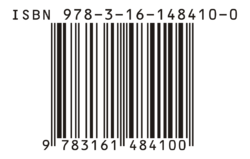International Standard Book Number
(cataloguing system) | |
|---|---|
 A 13-digit ISBN, 978-3-16-148410-0, as represented by an EAN-13 bar code | |
| Start | 1967 |
| A 13 digit numeric commercial book identifier which is intended to be unique | |
The International Standard Book Number (ISBN) is a numeric commercial book identifier which is intended to be unique. Occasionally, publishers erroneously assign an ISBN to more than one title — the first edition of The Ultimate Alphabet and The Ultimate Alphabet Workbook have the same ISBN, 0-8050-0076-3. Conversely, books are published with several ISBNs: A German second-language edition of Emil and the Detectives has the ISBNs 87-23-90157-8 (Denmark), 0-8219-1069-8 (United States), 91-21-15628-X (Sweden), 0-85048-548-7 (United Kingdom) and 3-12-675495-3 (Germany). In some cases, books sold only as sets share ISBNs. For example, the Vance Integral Edition used only two ISBNs for 44 books. Publishers purchase ISBNs from an affiliate of the International ISBN Agency.[1]
An ISBN is assigned to each separate edition and variation (except reprintings) of a publication. For example, an e-book, a paperback and a hardcover edition of the same book will each have a different ISBN. The ISBN is ten digits long if assigned before 2007, and thirteen digits long if assigned on or after 1 January 2007. Publishers were required to convert existing ISBNs from the 10-digit format to the 13-digit format (in their publication records) by 1 January 2007. For existing publications, the new 13-digit ISBN would only need to be added if (and when) a publication was reprinted. During the transition period, publishers were recommended to print both the 10-digit and 13-digit ISBNs on the verso of a publication's title page, but they were required to print only the 13-digit ISBN after 1 January 2007. The method of assigning an ISBN is nation-specific and varies between countries, often depending on how large the publishing industry is within a country.
The initial ISBN identification format was devised in 1967, based upon the 9-digit Standard Book Numbering (SBN) created in 1966. The 10-digit ISBN format was developed by the International Organization for Standardization (ISO) and was published in 1970 as international standard ISO 2108 (the 9-digit SBN code can be converted to a 10-digit ISBN by prefixing it with a zero digit '0').
Privately published books sometimes appear without an ISBN. The International ISBN Agency sometimes assigns such books ISBNs on its own initiative.[2]